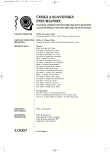Oculocutaneous Syndrome Associated with Prolonged Phenothiazines Therapy
Authors:
D. Dvořáková 1; S. Jirka 2
Authors‘ workplace:
Psychiatrická léčebna Jihlava
; ředitelka prim. MUDr. Z. Drlíková
Oční oddělení Nemocnice Jihlava
1; prim. MUDr. P. Pernica
2
Published in:
Čes. a slov. Psychiat., 103, 2007, No. 3, pp. 117-123.
Category:
Original Article
Overview
This paper describes phenothiazines-induced cutaneous and ocular changes and evaluates manifestation of these changes in the group of 27 patients long-termed hospitalized at Mental Hospital Jihlava. Abnormal skin pigmentation was seen altogether in 14 patients (52%) what is corresponding to the fact that nearly half of the investigated persons received chlorpromazine which is considered the most risky factor for these changes. Skin pigmentation also ocurred in 3 patients with levopromazine. Ocular changes appeared in 11 persons (41%), most of them manifestied both corneal and lens opacities. We did not discover phenothiazines retinopathy in any patient. Our results confirm that skin and ocular pigmentations are relatively common in chronic psychotic patients and they are dose and duration of treatment related.
Key words:
phenothiazines, chlorpromazine, abnormal skin pigmentation, ocular pigmentation.
Labels
Addictology Paediatric psychiatry PsychiatryArticle was published in
Czech and Slovak Psychiatry

2007 Issue 3
Most read in this issue
- Oculocutaneous Syndrome Associated with Prolonged Phenothiazines Therapy
- Parental Alienation Syndrome and Post Divorce Adaptation
- Fronto-temporal Disconnection in Schizophrenia
